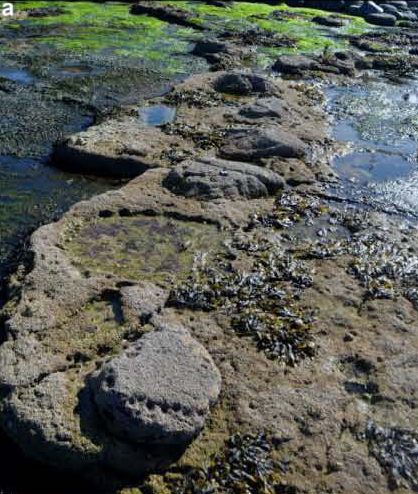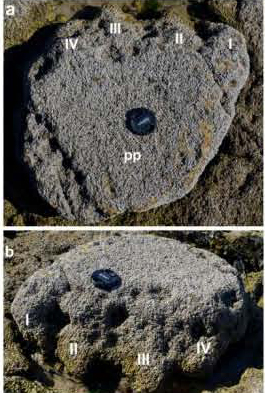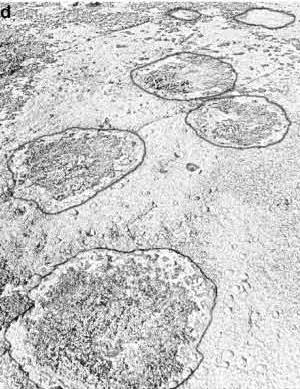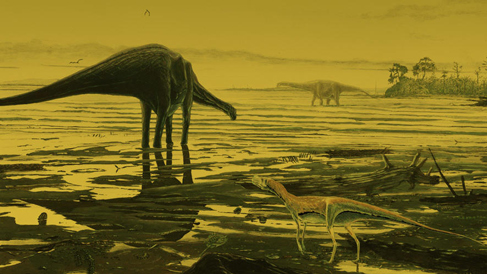Sauropod Tracks Suggest a Preference for Water
For much of the 19th and 20th centuries, those behemoths of the Dinosauria, the sauropods, were depicted as aquatic animals, at home in the deep water of large lakes, where their enormously heavy bodies could be supported by the water and their weak, peg-like teeth could cope with the soft and lush lakeside vegetation. A substantial amount of evidence was put forward by scientists to support this hypothesis, not least of which was trackway evidence.
Most sauropod tracks were associated with soft mud, the sort of conditions found close to large bodies of water. Therefore, it seemed logical to depict these super-sized reptiles as animals at home in lacustrine (lakes), estuaries or riverine dominated habitats. Thanks to some remarkable Middle Jurassic sauropod footprints, this idea of long-necked dinosaurs preferring to live near to water might just be resurrected and find favour once again in palaeontological circles.
Dinosaur Tracks (Sauropoda) Discovered on the Isle of Skye
Picture credit: University of Edinburgh/Scottish Journal of Geology
Went Out for An Ichthyosaur Came Back with an Ichnogenus!
A party of scientists from Edinburgh University in collaboration with local fossil experts were working on the northern part of the Isle of Skye conducting research into the fauna and flora preserved in strata that makes up the bay just south of the ruin of Duntulm Castle. Although it is difficult to precisely date the vertebrate fossils found in these rocks, these sediments are believed to preserve evidence of life during the Middle Jurassic and since there are only a handful of highly fossiliferous sites dating from this time in geological history to be found anywhere in the world, the Isle of Skye represents an extremely important location for scientists.
Ironically, the team, which included Dr Steve Brusatte from the School of GeoSciences (Edinburgh University), had set out to recover some Ichthyosaurus fossils but the area where the marine reptile lay remained covered by the high tide.
Sauropod Tracks
Although disappointed, the team continued to document the variety of fossils located on the foreshore and as the light from the relatively low sun cast shadows along the rocky coastline, Dr Brusatte and his colleague Dr Tom Challands came across some large lumps of raised rock. Protruding from one lump of rock were extensions of the material that gave the distinct impression of digits and substantial claws, particularly on digits I and II. This pattern is diagnostic of the hind footprint from a sauropod dinosaur.
The Left Hind Foot (Pes) of a Sauropod Dinosaur Isle of Skye
Picture credit: University of Edinburgh/Scottish Journal of Geology
The picture above shows one of the rear feet of the sauropod (left pes), the digits are marked and the lens cap, in the picture to provide scale, measures five centimetres in diameter. The prints are in hyporelief (convex and raised). The tracks were found in three beds in total (bed 34 and 35 provided trackways, whilst bed 9 provided single prints identified as those from a sauropod plus additional individual tridactyl prints identified as having been made by a large theropod.
The footprints, the largest of which is around seventy centimetres in diameter were made by animals that were around fifteen metres in length and weighed in excess of ten tonnes. The tracks are the first Sauropod tracks to be found north of the border and represent the largest dinosaur known from Scotland.
Long-Necked Dinosaurs Walking Across a Salt Water Lagoon
The beds from which the prints come from also contain shark teeth, and the remains of marine molluscs. The strata does not exhibit any signs of mud cracks or drying out, so this evidence, along with the associated fossils, suggests that the sauropods were wading across a shallow salt water lagoon. Although an ichnogenus has yet to be assigned to these tracks, the University of Edinburgh research team have proposed that the prints are similar to the ichnogenus Breviparopus or perhaps Parabrontopodus.
Sauropod Tracks Discovered on the Isle of Skye
Picture credit: University of Edinburgh/Scottish Journal of Geology
If you examine the picture above carefully, you can see that despite the size of the prints, they are quite close together. The footprints of titanosaurs for example, tend to be much wider apart. These are “narrow gauge” prints perhaps indicative of a cetiosaurid or a diplodocid dinosaur.
To view models and replicas of sauropod dinosaurs: Mojo Fun Prehistoric Animal Models.
Implications for the Habits of Sauropods
As sauropod prints are found in three different beds it could be suggested that these dinosaurs were frequent visitors to this sort of salt water habitat. Although, it has to be pointed out that it is difficult to determine how much time elapsed between the deposition of the different beds. The strata could have been laid down over a few centuries or there could be thousands of years between these bedding planes. One thing that the scientists can be fairly confident about is that between some of the beds in this area there are large concretions of limestone.
The algae and other micro-fossils such as dinoflagellate and preserved palynomorph fossils indicate that these sediments date from the Bathonian age (167.7 to 164.7 million years ago approximately).
A Line Drawing of Some of the Epirelief Prints Showing the “Narrow Gauge” of the Dinosaur Tracks
Picture credit: University of Edinburgh/Scottish Journal of Geology
Why Live Close to Salt Water?
Dr Challands described the moment when the team became aware of the significance of their discovery as an “epiphany”. Details of the tracks have been published in the “Scottish Journal of Geology” and these trackways and others like them found elsewhere in the world (including England), have led some palaeontologists to re-examine the evidence for sauropods being entirely terrestrial animals. The researchers writing in the journal state:
“The Skye site presents a confluence of evidence for sauropods living in the region of a submerged lagoon over multiple generations.”
There might have been a number of advantages for the sauropods if they lived close to large bodies of water, for example:
- Sandy beaches would have made natural thoroughfares for these large creatures providing access to the edge of forests adjacent to the shoreline.
- Open areas would have limited the chances of these plant-eating dinosaurs being ambushed by theropods.
- Lagoons are associated with abundant food supplies.
- By wading or wallowing in the water these creatures would have been able to cool their large bodies very effectively.
- The salt water and mud would have provided relief from biting insects.
- Few predators would have been prepared to venture out into the lagoon to hunt the sauropods.
The Isle of Skye in the Middle Jurassic
Picture credit: Jon Hoad
The illustration above shows two sauropods on the mud flats of the lagoon, whilst in the foreground a small, theropod (Ornitholestinae subfamily) looks on warily.
A Significant Middle Jurassic Discovery
Commenting on the trace fossils and their importance to palaeontology, Dr Brusatte stated:
“The Middle Jurassic was a really interesting period in the history of life, when there was a whole lot of evolution going on. What is really frustrating is that we have a lot of fossils from different places with fossils from the Early Jurassic and the Late Jurassic, but there is relatively little fossil-bearing Middle Jurassic rock around.”
The Isle of Skye fossils pose some intriguing questions, these tracks most likely were made by primitive sauropods at a time when the Sauropoda were beginning to radiate, differentiate and evolve into a number of new forms.
In addition, the strata preserves evidence of multiple generations of sauropods inhabiting lagoonal environments, which suggests the intriguing possibility that these huge creatures might have sought out such habitats, preferring them to inland areas.
Do these tracks preserve evidence of Isle of Skye sauropods and their water world?











Leave A Comment